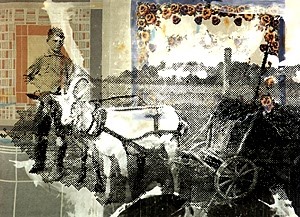Polke Dots: Remembering Sigmar Polke

When Sigmar Polke’s family crossed over to the freedom of West Berlin from the oppression of East Berlin on the subway in 1953, 12-year-old Sigmar feigned sleep to add to the picture of normalcy for his fugitive family. Polke (pronounced “polka,” like the dance), who passed away last Thursday, feigned many things during his life in his art, but usually to question the idea of normalcy, especially the rushed, forced normalcy of his native Germany after World War II. With a smile on his lips, Polke never slept through an opportunity to poke fun at the establishment—artistic, social, or political—and help people connect the dots, usually closely spaced, between apparent normality and absurd abnormality.
What Kurt Vonnegut was to postwar literature, Polke was to postwar art. Neither could take anything seriously, including themselves. Each saw the risk of building up false idols after the fascist faith that drove Europe into a hellish depth and threatened to take the rest of the world with it. In the face of such dread seriousness, each armed himself with laughter and wit. Their memories will endure as long as there are cults of personality looming on the horizon and big men asking to be cut down to size.
One of my favorite works by Polke is his 1992 painting Der Ziegenwagen, or “The Goatwagon” (pictured above). Polke enlarged an old photo of a poor boy with a goat cart and set it against flowered and patterned tablecloths he had stitched together, as if the simple subject were worthy of medieval tapestry treatment. By enlarging the photo, Polke revealed the Benday dots of the photographic process, much as Roy Lichtenstein painted in his Pop Art comics paintings. But where Lichtenstein borrowed a slice of melodrama from the comic books in his art and elevated it to high art, Polke makes fun of the operatic heights even the simplest subjects can be given by the ablest of spin doctors. Polke never slept comfortably in a world in which anything could be lorded over another, an aftershock of his childhood years spent in Hitler’s Germany. Polke never wanted the shock value of those Hitler years to be lost on following generations, but realized that the message was best delivered by way of joke.
Joseph Beuys, Gerhard Richter, Georg Baselitz, and other German artists all dealt with the German postwar legacy in different ways, but none ever matched Polke’s capacity for poking fun. When asked to name a price for a work, Polke sometimes simply doubled his age and then added a trio of zeroes to the end, which allowed him simultaneously to thumb his nose at the art world and the financial buzzards that circled it. Each generation needs a Polke (or a Vonnegut, or a Twain, or a Carlin, etc.) to make it laugh, make it cringe, and make it think. Polke loved to create artworks that mimicked stain glass by their colorful translucency—a transparency of sorts, but with personality intervening. Polke asked for total transparency—not just of government but of life itself, as if illusion itself could be outlawed—but knew that it took a special mind and eye to make that transparency clear to the masses. Perhaps the passing of this special mind and eye will spur some young artist out there to pick up the torch and hold it up as a beacon.





